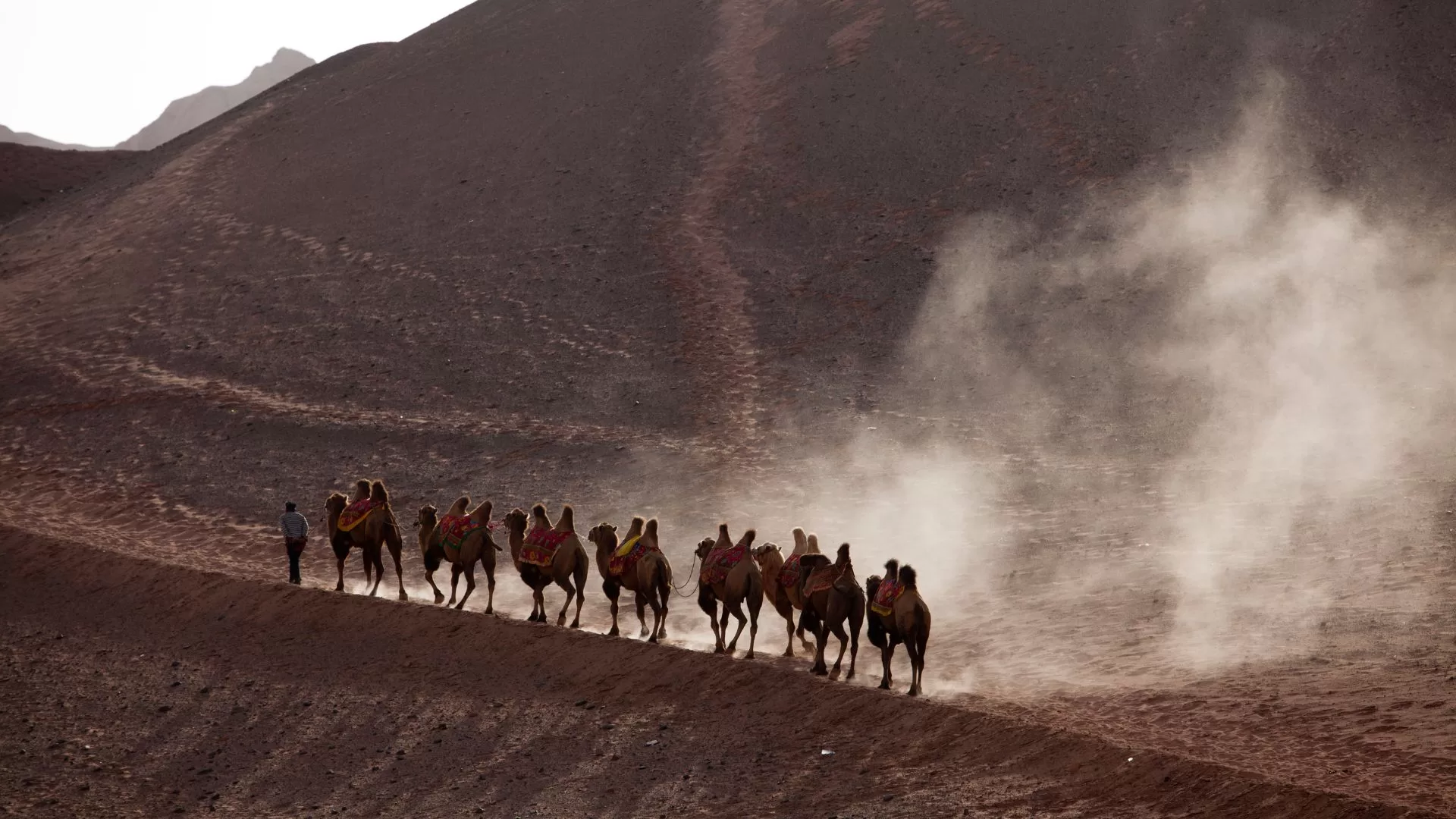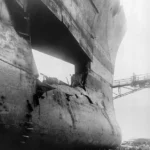The Silk Road spanned over 4,000 miles across continents, creating a vast network of trade routes that shaped human civilization for centuries. This ancient network of paths connected China to Europe and the Middle East between 130 BCE and 1453 CE, facilitating not just the exchange of silk and spices, but also technology, religions, and cultural ideas.
Merchants, pilgrims, and explorers traversed treacherous deserts, mountains, and seas to transport precious goods like silk, tea, and porcelain from East to West. Cities along the route grew into vibrant centers of commerce and cultural exchange, from Chang’an in China to Constantinople in modern-day Turkey.
Beyond commerce, the Silk Road served as humanity’s first information superhighway. Buddhist monks spread their teachings eastward from India, while paper-making techniques traveled west from China to transform communication across Europe and the Middle East.
Origins and Development
The Silk Road emerged from ancient trade networks to become history’s most significant commercial artery, stretching over 4,000 miles from China to the Mediterranean. Trade along these routes shaped civilizations, spread cultures, and facilitated exchanges of goods and ideas for over 1,500 years.
Pre-Silk Road Trade Routes
Small-scale trade networks existed across Central Asia as early as 3000 BCE. Nomadic tribes exchanged jade, lapis lazuli, and other precious stones between settlements.
By 2000 BCE, the Steppe Route connected various civilizations across the Eurasian grasslands. Merchants traveled on horseback and camel, trading bronze weapons, furs, and domesticated horses.
The Persian Royal Road, established around 500 BCE under Darius I, linked Susa to Sardis across 1,677 miles. This route featured regular rest stops and a sophisticated relay messenger system.
Rise of the Silk Road
Chinese emperor Wu of Han officially established the Silk Road in 130 BCE by sending diplomat Zhang Qian on missions to Central Asia. These expeditions fostered diplomatic relations and opened new trade possibilities.
Chinese silk became the most prized commodity, though jade, spices, and precious metals also flowed along the routes. The Han Dynasty protected merchants and improved infrastructure by building walls and watchtowers.
Desert oasis cities like Dunhuang and Samarkand grew into wealthy trading hubs. These cities provided essential services to merchants, including lodging, supplies, and banking facilities.
Silk Road Peak and Decline
The Silk Road reached its golden age during the Tang Dynasty (618-907 CE). Chang’an, the Tang capital, became the world’s largest city with over one million inhabitants.
Trade volumes increased significantly as the Mongol Empire unified much of Asia under single rule. The Pax Mongolica provided unprecedented security for merchants traveling the routes.
Maritime trade routes gradually replaced land-based paths by the 15th century. The rise of the Ottoman Empire and the development of seafaring technology made ocean transport more practical and profitable.
Disease spread along the routes, with the Bubonic Plague devastating populations in the 14th century. This pandemic, combined with political instability, contributed to the Silk Road’s eventual decline.
Major Silk Road Routes
The Silk Road branched into three primary trading arteries that stretched across Asia, connecting China to Europe and the Middle East through diverse landscapes and climates. Merchants adapted their routes based on weather conditions, political stability, and the availability of supplies.
Northern Route
The northern branch of the Silk Road began in Chang’an (modern Xi’an) and traversed the Gansu Corridor into Central Asia. Traders crossed the Tarim Basin, following oasis cities like Turpan, Kucha, and Kashgar.
The route split at Kashgar, with one path leading through the Fergana Valley and another crossing the Pamir Mountains. These paths reconnected in Samarkand, a major trading hub in modern-day Uzbekistan.
From Samarkand, caravans traveled to Merv and Bukhara before reaching the Caspian Sea. The final leg connected to Constantinople through Persian and Armenian territories.
Southern Route
The southern path started in Luoyang and crossed the Karakoram Mountains through Dunhuang. Merchants navigated challenging terrain through Khotan and Yarkand, vital jade trading centers.
This route followed the northern edge of the Tibetan Plateau through modern-day Pakistan and Afghanistan. Key stops included Balkh and Bamiyan, renowned for Buddhist monasteries and art.
The path continued through Persia, reaching Ctesiphon and Antioch. Goods moved onward to Mediterranean ports like Tyre and Alexandria.
Maritime Pathways
Sea routes complemented land passages, connecting Chinese ports like Guangzhou to Southeast Asian harbors. Ships navigated through the Strait of Malacca, linking to Indian Ocean trade networks.
Arab and Persian merchants dominated maritime trade between India and East Africa. Key ports included Calicut, Hormuz, and Muscat.
The sea routes merged with land paths at Alexandria and other Mediterranean ports, creating an integrated trading system. Ships carried spices, ceramics, and textiles alongside traditional silk cargo.
Cultural and Economic Impact
The Silk Road transformed the ancient world through unprecedented trade volumes and cross-cultural connections. Merchants exchanged not just goods but also ideas, technologies, and beliefs across vast distances, creating lasting impacts that shaped civilizations for centuries.
Trade and Commerce
Chinese silk became the most sought-after commodity along the route, commanding high prices in Roman markets. A single bolt of silk could sell for the equivalent of 35,000 USD in today’s currency.
Merchants traded jade, spices, precious metals, and exotic animals alongside practical items like saddles and weaponry. The route established standardized trading practices and created wealthy merchant classes in major trading hubs.
Paper currency emerged as a practical solution for merchants carrying large amounts of wealth across dangerous terrain. The development of credit systems and merchant banks followed.
Cultural Exchange
The mixing of artistic styles created new forms of expression, with Greek-influenced Buddha statues appearing in Central Asia and Chinese motifs decorating Persian textiles.
Languages evolved as traders developed pidgin languages to communicate. Persian became the lingua franca of the route, while loan words spread between Chinese, Arabic, and European languages.
Musical instruments like the lute traveled from Persia to China, while Chinese erhu techniques influenced Central Asian music. New food preparations and cooking methods spread as merchants shared recipes and ingredients.
Religious Influence
Buddhism spread from India to China along the trade routes, with merchants funding temples and monasteries that served as rest stops.
Islamic teachings reached Southeast Asia through Arab traders, while Nestorian Christianity moved eastward into China. The route enabled religious scholars to translate and share sacred texts across cultures.
Zoroastrian temples, Buddhist stupas, and Islamic mosques often stood side by side in trading cities, creating unique spaces of religious tolerance and cultural fusion. Religious art and architecture blended local and foreign elements.
Notable Goods Traded
The Silk Road facilitated the exchange of diverse and valuable commodities that shaped economies, cultures, and societies across continents. Merchants transported precious materials and rare items that commanded high prices in distant markets.
Silk
Chinese silk stood as the most prized commodity on these ancient trade routes. The luxurious fabric’s production remained a closely guarded secret in China for centuries.
Roman aristocrats paid enormous sums for silk garments, often trading gold of equal weight for the fabric. A single silk robe could cost the equivalent of several thousand dollars in today’s currency.
Chinese merchants traded raw silk, damask, brocade, and other woven varieties. The material’s lightweight nature and high value made it an ideal trading good for long-distance transport.
Spices
Pepper from India dominated the spice trade, with Roman merchants paying up to 15 gold pieces per pound. Black, white, and long pepper varieties traveled westward in large quantities.
Cinnamon from Ceylon and cassia from China commanded premium prices in Mediterranean markets. These aromatic barks served both culinary and medicinal purposes.
Traders also carried ginger, turmeric, cardamom, and saffron along the routes. Many spices served dual roles as preservatives and status symbols among wealthy Europeans.
Precious Metals and Gems
Gold from Rome flowed eastward in exchange for luxury goods. Persian and Central Asian mines supplied silver to both eastern and western markets.
Jade held immense value in Chinese culture, with the finest specimens coming from Khotan. Merchants transported both raw jade and carved pieces.
Lapis lazuli from Afghan mines traveled to Egypt and Mesopotamia. The deep blue stone adorned royal jewelry and religious artifacts.
Other Exotic Goods
Glass products from Roman and Persian workshops found eager buyers in China. Craftsmen developed new techniques as they studied traded glass pieces.
Ivory from African elephants moved eastward through Arab traders. Artisans carved the material into decorative items and practical objects.
Arabian frankincense and myrrh served religious and medicinal purposes. These fragrant resins commanded prices higher than gold in some markets.
Chinese paper and Indian cotton textiles transformed communication and clothing in the West. These materials offered practical alternatives to expensive parchment and silk.
Influential Civilizations and Figures
The Silk Road’s success depended on the major empires and cultures that controlled its various segments. Key traders, diplomats, and explorers helped establish and maintain these vital trade networks across Asia and Europe.
China’s Han Dynasty
Emperor Wu of Han officially established the Silk Road in 130 BCE through diplomatic missions and military campaigns. His envoy Zhang Qian played a crucial role in forming early trade relationships with Central Asian kingdoms.
The Han Dynasty (206 BCE – 220 CE) maintained strict control over silk production and trade, creating a monopoly that generated immense wealth. Their technological innovations in silk-making remained closely guarded secrets for centuries.
Han military outposts and watchtowers protected merchants along the eastern portions of the route. These garrisons evolved into vital trading posts and cultural exchange centers.
Roman Empire
Roman traders primarily operated in the western segments of the Silk Road, establishing trading posts from Syria to Parthia. Their demand for Chinese silk and other Asian luxuries drove much of the route’s commerce.
The Romans established key trading cities like Antioch and Palmyra, which became crucial intermediary points for east-west exchange. These cities grew wealthy from tariffs and trade services.
Roman gold and silver coins became a standard currency along the route, fostering international commerce. Archaeologists have discovered Roman coins as far east as China and Japan.
Central Asian Cultures
The Sogdians emerged as master traders, establishing a network of merchant communities from China to Constantinople. Their language became the lingua franca of Silk Road commerce.
The Kushan Empire controlled crucial middle segments of the route, facilitating trade between China and Rome. Their multicultural society embraced Buddhist, Greek, and Persian influences.
Nomadic groups like the Xiongnu and Yuezhi played vital roles in transmitting goods and culture across Central Asia. Their mobility and local knowledge made them invaluable partners in long-distance trade.
Noteworthy Explorers
Marco Polo’s 13th-century journeys documented crucial details about Silk Road cities and customs. His writings introduced many Europeans to Asian cultures and trade possibilities.
Xuanzang, a 7th-century Chinese Buddhist monk, traveled to India via the Silk Road. His detailed travel account Great Tang Records on the Western Regions provided valuable information about Central Asian kingdoms.
Ibn Battuta explored the eastern Silk Road in the 14th century. His accounts described the thriving Muslim trading communities along the route.
Silk Road’s Scientific and Technological Diffusion
The Silk Road served as a vital conduit for the exchange of scientific discoveries and technological innovations between Asia and Europe. Knowledge flowed freely across this network, transforming societies and accelerating human progress.
Papermaking and Printing
Paper manufacturing techniques spread from China to the Islamic world in the 8th century through captured Chinese papermakers in Samarkand. This knowledge reached Europe by the 12th century, revolutionizing information storage and transmission.
The art of woodblock printing traveled along similar routes. Chinese printed materials, including Buddhist texts and playing cards, inspired Middle Eastern and European printers to develop their own techniques.
Paper currency, first developed in China, spread across the Silk Road networks. Merchants and travelers carried these notes, introducing the concept of paper money to new regions.
Gunpowder and Compass
Chinese alchemists discovered gunpowder in the 9th century while searching for an elixir of immortality. The formula spread westward through Arab traders and scholars, reaching Europe by the 13th century.
The magnetic compass, initially used for feng shui in China, evolved into a crucial navigation tool. Arab merchants adopted it for sea travel by the 11th century, and European sailors began using it shortly after.
These innovations transformed warfare and navigation globally. Islamic armies developed early firearms, while European shipbuilders combined compass technology with advanced shipmaking techniques.
Mathematics and Astronomy
Indian mathematical concepts, including the decimal system and zero, traveled to Europe through Arab mathematicians along the Silk Road. Persian scholars translated and expanded upon these works in major trading cities.
Chinese astronomers shared their precise celestial observations and calendar systems with cultures along the route. The astrolabe, enhanced by Persian astronomers, became an essential tool for navigation and timekeeping.
Arab mathematical innovations, including algebra, spread eastward to China and westward to Europe through merchant scholars and translated texts.
Challenges and Dangers of Travel
Merchants and travelers faced life-threatening obstacles along the Silk Road’s vast network of trade routes spanning Asia, Africa, and Europe. Extreme natural barriers, hostile territories, and criminal threats created constant risks for those brave enough to make the journey.
Geographic Obstacles
The Silk Road crossed some of Earth’s most formidable terrain. The Taklamakan Desert’s intense heat and sandstorms claimed countless lives, earning it the name “Desert of Death” in local languages.
Treacherous mountain passes through the Himalayas and Tian Shan ranges forced travelers to navigate narrow paths along steep cliffs. Extreme altitudes and harsh weather conditions made these crossings especially dangerous in winter months.
Crossing the steppes of Central Asia exposed caravans to temperatures ranging from scorching heat to bitter cold. Limited water sources and scarce shelter left travelers vulnerable to the elements.
Political Conflicts
Local rulers frequently imposed heavy taxes and tariffs on merchants passing through their territories. These fees could consume much of a caravan’s potential profits.
Wars between rival empires disrupted established trade routes and forced merchants to find alternative paths. The frequent shifts in political control meant traders needed to constantly adapt to new rulers and regulations.
Armed conflicts made certain regions completely impassable. Merchants had to stay informed about political situations and maintain relationships with multiple authorities to ensure safe passage.
Bandits and Pirates
Organized bandit groups targeted wealthy merchant caravans, especially in remote mountain passes and desert regions. Traders traveled in large armed groups for protection, though this increased their visibility to potential attackers.
Maritime routes faced constant threats from pirates operating in the Indian Ocean and South China Sea. Ships carried valuable cargo and had limited means of defense against well-armed pirate vessels.
Corrupt local officials sometimes collaborated with bandits, making it difficult for merchants to know whom to trust. Many traders employed local guides and paid for protection from regional tribes to reduce their risk of attack.
References
- UNESCO (n.d.) – The Silk Roads: A Global History of Exchange and Cultural Interaction Link
- Hansen, V. (2012) – The Silk Road: A New History Link
- Liu, X. (2010) – The Silk Road in World History Link
- Foltz, R. (2000) – Religions of the Silk Road: Premodern Patterns of Globalization Link
- Frankopan, P. (2015) – The Silk Roads: A New History of the World Link
- Wood, F. (2002) – The Silk Road: Two Thousand Years in the Heart of Asia Link
- Brook, T. (2013) – Mr. Selden’s Map of China: Decoding the Secrets of a Vanished Cartographer Link




